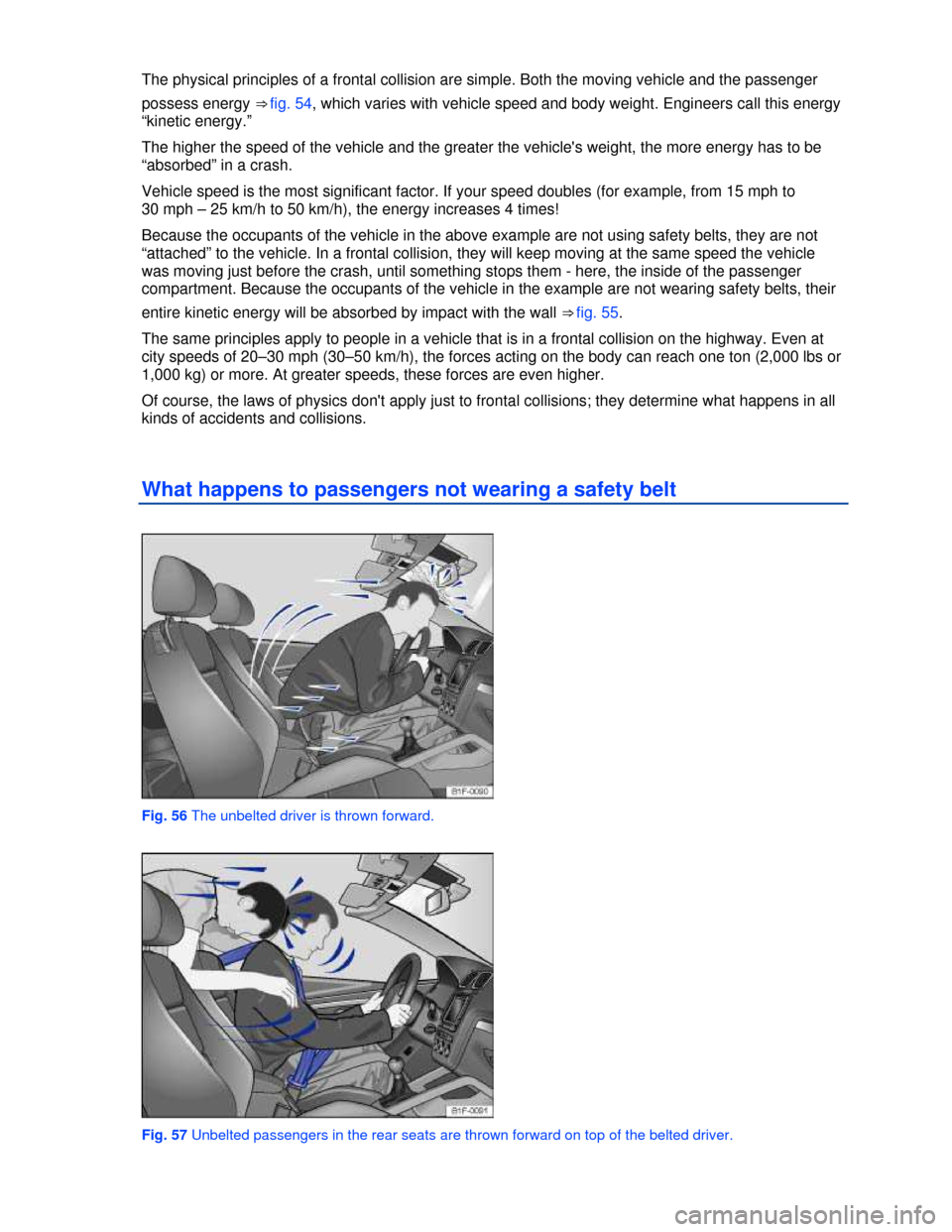2013 VOLKSWAGEN EOS weight
[x] Cancel search: weightPage 26 of 329

¥ Properly fasten your safety belt before driving the vehicle and wear your safety belt properly at all
times while driving. Make sure that all passengers do the same
¥ Only transport as many passengers as there are seats and safety belts available.
¥ Never drive if your driving ability has been impaired, for example by medication, alcohol or illegal
drugs.
¥ Never let passengers or phone calls distract you while driving, and never take your attention off the
road while using vehicle software or adjusting vehicle equipment or accessories.
¥ Always adapt your speed and driving style to visibility, weather, road, and traffic conditions.
¥ Always obey traffic laws and speed limits.
¥ On long trips make frequent rest stops – at least once every 2 hours.
¥ Secure animals in the vehicle with a system that corresponds to weight and size.
WARNING
Always observe traffic rules and posted speed limits and use common sense. Your good
judgment can mean the difference between arriving safely at your destination and being se-
riously injured in a crash or other kind of accident.
Regular service and maintenance of your vehicle is important both for operational and driving
safety and to help prolong your vehicle's service life. Always follow the scheduled maintenance inter-
vals in the ⇒ Booklet Warranty and Maintenance, especially for changing the brake fluid. Hard use,
frequent stop-and-go driving, driving in very dusty areas, trailer towing, and other factors may make it
necessary to have the vehicle serviced more frequently. Ask an authorized Volkswagen dealer or an
authorized Volkswagen Service Facility for more information.
Driving in other countries
�
Page 77 of 329

WARNING
Not wearing a safety belt or wearing an improperly positioned safety belt increases the risk of
severe personal injury or death. Safety belts offer optimum protection only when they are
used properly.
�x Properly worn safety belts are the single most effective means of reducing the risk of
serious injury and death in a collision or other accident. For this reason, always wear your
safety belt properly and make sure all passengers wear their safety belts properly as well
whenever the vehicle is moving.
�x The driver must always make sure that every person in the vehicle is properly seated on a
seat of his or her own, properly fastens the safety belts belonging to that seat before the
vehicle starts to move, and keeps the belts properly fastened while riding in the vehicle. This
applies even when just driving around town. Therefore, always wear your safety belts and
make sure that everybody in your vehicle is properly restrained.
�x Always secure children in the vehicle with a restraint system appropriate for their age,
weight and height
�x Always fasten safety belts correctly before driving off and make sure that all passengers
are properly restrained.
�x Never attach the safety belt to the buckle of another seat. Attaching the safety belt to the
wrong buckle will reduce safety belt effectiveness and can cause serious personal injury.
�x Never let any objects or liquids get into the safety belt latch and prevent it from working
properly.
�x Never remove a safety belt while the vehicle is moving. Doing so will increase your risk of
being injured or killed.
�x Never strap more than one person, including small children, into any single safety belt.
�x Never let children or babies ride sitting on your lap, and never place a safety belt over a
child sitting on your lap.
�x Never wear belts over rigid or breakable objects in or on your clothing, such as
eyeglasses, pens, keys, etc., as these may cause injury.
�x Several layers of heavy clothing (such as a coat worn over top of a sports jacket) may
interfere with proper positioning of the safety belt and reduce the overall effectiveness of the
system.
�x Never use comfort clips or devices that create slack in the shoulder belt. However, special
clips may be required for the correct use of some child restraint systems.
�x Safety belts offer optimum protection only when the seat backrest is upright and belts are
correctly positioned on the body.
Page 81 of 329

The physical principles of a frontal collision are simple. Both the moving vehicle and the passenger
possess energy ⇒ fig. 54, which varies with vehicle speed and body weight. Engineers call this energy
“kinetic energy.”
The higher the speed of the vehicle and the greater the vehicle's weight, the more energy has to be
“absorbed” in a crash.
Vehicle speed is the most significant factor. If your speed doubles (for example, from 15 mph to
30 mph – 25 km/h to 50 km/h), the energy increases 4 times!
Because the occupants of the vehicle in the above example are not using safety belts, they are not
“attached” to the vehicle. In a frontal collision, they will keep moving at the same speed the vehicle
was moving just before the crash, until something stops them - here, the inside of the passenger
compartment. Because the occupants of the vehicle in the example are not wearing safety belts, their
entire kinetic energy will be absorbed by impact with the wall ⇒ fig. 55.
The same principles apply to people in a vehicle that is in a frontal collision on the highway. Even at
city speeds of 20–30 mph (30–50 km/h), the forces acting on the body can reach one ton (2,000 lbs or
1,000 kg) or more. At greater speeds, these forces are even higher.
Of course, the laws of physics don't apply just to frontal collisions; they determine what happens in all
kinds of accidents and collisions.
What happens to passengers not wearing a safety belt
Fig. 56 The unbelted driver is thrown forward.
Fig. 57 Unbelted passengers in the rear seats are thrown forward on top of the belted driver.
Page 120 of 329

WARNING
Heavy loads will influence the way your vehicle handles and increase stopping distances.
Heavy loads that are not properly stowed or secured can cause loss of control and serious
injury.
�x Secure the load properly to keep it from shifting.
�x Always remember when transporting heavy objects that a change in the center of gravity
also changes the way your vehicle handles:
– Always distribute the load as evenly as possible.
– Secure heavy objects properly as far forward in the luggage compartment as possible.
– Always tie down heavy items securely with suitable straps in the luggage
compartment.
�x Never exceed the Gross Axle Weight Rating or the Gross Vehicle Weight Rating on the
safety compliance sticker on the left door jamb. Exceeding permissible weight can cause the
vehicle to skid and handle differently.
�x Always adapt your speed and driving to the heavier load and the weight distribution in the
vehicle. Take road, weather, traffic, and visibility conditions into account as well.
�x Always accelerate gently and avoid sudden braking and driving maneuvers.
�x Always brake earlier than you would if you were not driving a loaded vehicle.
NOTICE
�x When the CSC roof opens (goes down), it folds completely into the luggage compartment.
The open CSC roof fills all the space above and on both sides of the cover that is installed
inside the luggage compartment. When the CSC roof opens and retracts, it must be able to
lower itself completely into the luggage compartment without any interference.
�x When you put the roof down, items
– to the left or right of the luggage compartment cover,
– on top of the luggage compartment cover, or
– above the level of the luggage compartment cover at the rear of the vehicle will prevent the roof
from folding up completely in the luggage compartment and will damage the CSC roof. Damage to
the CSC roof caused by items in those areas of the luggage compartment where the CSC
roof segments are stored when retracted will not be covered by any Volkswagen Limited
Warranty.
�x The heating wires in the rear window can be severely damaged by hard or sharp things in
the area below the rear window.
Page 125 of 329

WARNING
Heavy loads can change the way your vehicle handles and increase stopping distances.
Heavy loads that are not properly stowed or secured can shift suddenly, causing loss of
control and serious injury.
�x Secure the load properly to keep it from shifting.
�x Always remember when transporting heavy objects that they change the vehicle's center
of gravity and also the way it handles.
– Always distribute the load as evenly as possible.
– Secure heavy objects as far forward in the luggage compartment as possible.
�x Always tie down heavy items securely with suitable straps.
�x Never exceed the Gross Axle Weight Rating or the Gross Vehicle Weight Rating on the
safety compliance sticker on the left door jamb. Exceeding permissible weight can cause the
vehicle to skid and handle differently.
�x Always adapt speed and driving to the heavier load and the weight distribution in the
vehicle. Take road, weather, traffic, and visibility conditions into account as well.
�x Always accelerate gently and avoid sudden braking and driving maneuvers.
�x Always brake earlier than you would if you were not driving a loaded vehicle.
Weights and axle weights
�
Page 126 of 329

WARNING
Exceeding maximum permissible weight ratings can result in vehicle damage, accidents, and
serious personal injury.
�x Never let the actual weights at the front and rear axles exceed the permissible Gross Axle
Weight Rating. Also, never let the total of these actual weights exceed the Gross Vehicle
Weight Rating.
�x Always remember that the vehicle's handling and braking will be affected by extra load
and the distribution of this load. Adjust your speed accordingly.
NOTICE
�x Always distribute the load evenly and as low as possible in the vehicle. The vehicle capacity
weight figures apply when the load is distributed evenly in the vehicle (passengers and
luggage).
�x When transporting a heavy load in the luggage compartment, carry the load as close to the
rear axle (as far forward) as possible so that the vehicle's handling and braking are affected as
little as possible.
Page 128 of 329

WARNING
Unsecured or incorrectly stowed items can fly through the vehicle, causing serious personal
injury during hard braking or sharp steering or in an accident. Loose items can also be struck
and thrown through the passenger compartment by the front airbags if they inflate. To help
reduce the risk of serious personal injury:
�x Always stow all objects securely in the vehicle. Always put luggage and heavy items in the
luggage compartment.
�x Always secure objects in the passenger compartment properly with suitable straps so that
they cannot move into the deployment zone of a side or front airbag during sudden braking,
in a sudden maneuver, or in a collision.
�x Always keep storage compartments closed while driving.
�x Never stow hard, heavy, or sharp objects in the vehicle's open storage compartments, on
the shelf behind the rear seat bench, or on the top of the instrument panel.
�x Always remove hard, heavy, or sharp objects from clothing and bags in the vehicle
interior and stow them securely in the luggage compartment.
WARNING
Transporting heavy objects causes the handling characteristics of the vehicle to change and
increases braking distances. Heavy loads which are not properly stowed or secured in the
vehicle can lead to a loss of vehicle control and cause serious personal injury.
�x Transporting heavy items causes the handling characteristics of the vehicle to change by
shifting the vehicle's center of gravity.
�x Always distribute luggage evenly and as low as possible within the vehicle. The vehicle
capacity weight figures apply when the load is distributed evenly in the vehicle (passengers
and luggage).
�x Always stow luggage and heavy items in the luggage compartment as far forward of the
rear axle as possible and secure them with appropriate straps.
�x Never exceed the vehicle's Gross Vehicle Weight Rating or Gross Axle Weight Ratings,
which are printed on the Safety Compliance Certification Label located on the door jamb of
the driver door. Exceeding the permissible weight can cause the vehicle to skid and behave
differently.
�x Always adapt your speed and driving style to accommodate your payload and its weight
distribution within your vehicle.
�x Be especially cautious and gentle when stepping on the accelerator pedal and avoid
sudden braking and other maneuvers.
�x Brake earlier than you would if you were not driving a loaded vehicle.
NOTICE
The defroster heating wires in the rear window can be damaged by objects that rub against
them.
Page 133 of 329

WARNING
Improper use of the trailer hitch can cause accidents and injuries. An improperly installed,
incorrect, or damaged trailer hitch can cause the trailer to separate from the towing vehicle
and cause serious personal injuries.
�x Only use an undamaged, properly mounted trailer hitch.
�x Never repair or modify the trailer hitch.
�x To reduce the risk of injury in rear-end collisions, and the risk to pedestrians and cyclists
when the vehicle is parked, always remove the ball mount when you are not towing a trailer.
�x Never install a “weight distributing” or “load equalizing” trailer hitch on your vehicle. The
vehicle was not designed for these kinds of trailer hitches. The trailer hitch attachment can
fail, causing the trailer to tear loose from the vehicle.
WARNING
Improper trailer towing can cause loss of vehicle control and serious personal injury.
�x Driving with a trailer and carrying heavy or large things can change the way the vehicle
handles, increase the distance it needs to stop safely, and cause accidents.
�x Always secure the load properly with suitable and undamaged straps so that the load will
not shift.
�x Always adapt your speed and driving to the heavier load and the weight distribution in the
vehicle. Take road, weather, traffic, and visibility conditions into account as well.
�x Reduce your speed even more than you otherwise would when going downhill and under
unfavorable load, weather, or wind conditions.
�x Trailers with a high center of gravity tip more easily than trailers with a low center of
gravity.
�x Always avoid sudden maneuvers and hard braking.
�x Be especially careful when passing other vehicles.
�x Reduce speed immediately if the trailer shows the slightest sign of swaying.
�x Never try to stop the swaying by accelerating.
�x Always obey speed limits. In some areas, the speed limits for vehicles towing trailers are
lower than for vehicles without trailers. Never drive faster than 50 mph (80 km/h; under
exceptional circumstances 60 mph - 100 km/h) when towing a trailer. This applies even if the
local speed limit is higher.
If you are driving a new vehicle or a vehicle with a new or rebuilt engine, do not tow a trailer
during the break-in period, about 600 miles (1000 km)
If you tow a trailer, your vehicle may need maintenance more often because of the extra load it
has to move.
When you are not towing, remove the trailer hitch ball. This helps keep the trailer hitch from
causing damage to your vehicle and to others if your vehicle is hit from behind.
Some models need a trailer hitch to tow or tow-start other vehicles. You may want to always
carry the ball mount in the vehicle after it has been removed. Be sure to stow it securely.